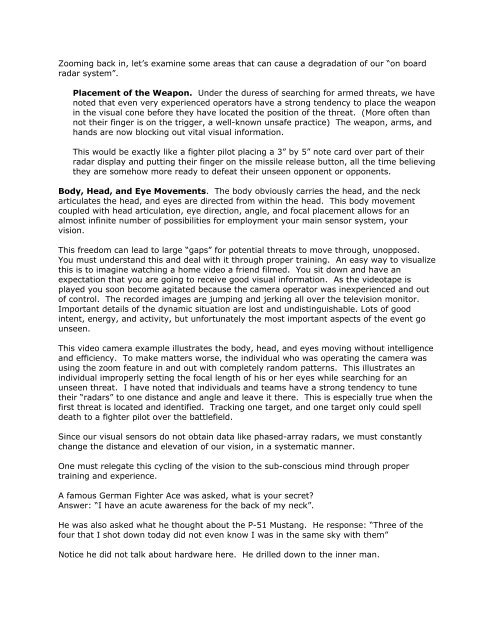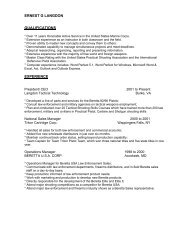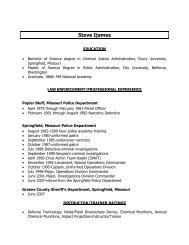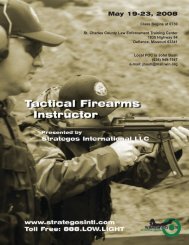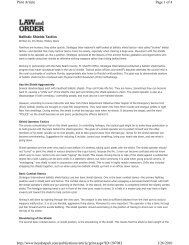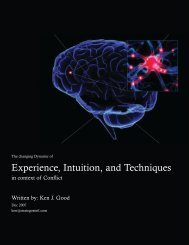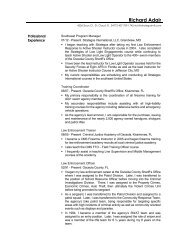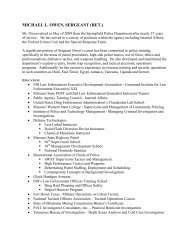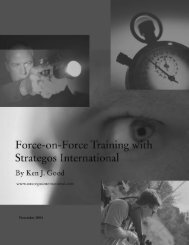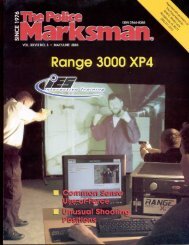Got a Second? - Strategos International
Got a Second? - Strategos International
Got a Second? - Strategos International
Create successful ePaper yourself
Turn your PDF publications into a flip-book with our unique Google optimized e-Paper software.
Zooming back in, let’s examine some areas that can cause a degradation of our “on board<br />
radar system”.<br />
Placement of the Weapon. Under the duress of searching for armed threats, we have<br />
noted that even very experienced operators have a strong tendency to place the weapon<br />
in the visual cone before they have located the position of the threat. (More often than<br />
not their finger is on the trigger, a well-known unsafe practice) The weapon, arms, and<br />
hands are now blocking out vital visual information.<br />
This would be exactly like a fighter pilot placing a 3” by 5” note card over part of their<br />
radar display and putting their finger on the missile release button, all the time believing<br />
they are somehow more ready to defeat their unseen opponent or opponents.<br />
Body, Head, and Eye Movements. The body obviously carries the head, and the neck<br />
articulates the head, and eyes are directed from within the head. This body movement<br />
coupled with head articulation, eye direction, angle, and focal placement allows for an<br />
almost infinite number of possibilities for employment your main sensor system, your<br />
vision.<br />
This freedom can lead to large “gaps” for potential threats to move through, unopposed.<br />
You must understand this and deal with it through proper training. An easy way to visualize<br />
this is to imagine watching a home video a friend filmed. You sit down and have an<br />
expectation that you are going to receive good visual information. As the videotape is<br />
played you soon become agitated because the camera operator was inexperienced and out<br />
of control. The recorded images are jumping and jerking all over the television monitor.<br />
Important details of the dynamic situation are lost and undistinguishable. Lots of good<br />
intent, energy, and activity, but unfortunately the most important aspects of the event go<br />
unseen.<br />
This video camera example illustrates the body, head, and eyes moving without intelligence<br />
and efficiency. To make matters worse, the individual who was operating the camera was<br />
using the zoom feature in and out with completely random patterns. This illustrates an<br />
individual improperly setting the focal length of his or her eyes while searching for an<br />
unseen threat. I have noted that individuals and teams have a strong tendency to tune<br />
their “radars” to one distance and angle and leave it there. This is especially true when the<br />
first threat is located and identified. Tracking one target, and one target only could spell<br />
death to a fighter pilot over the battlefield.<br />
Since our visual sensors do not obtain data like phased-array radars, we must constantly<br />
change the distance and elevation of our vision, in a systematic manner.<br />
One must relegate this cycling of the vision to the sub-conscious mind through proper<br />
training and experience.<br />
A famous German Fighter Ace was asked, what is your secret<br />
Answer: “I have an acute awareness for the back of my neck”.<br />
He was also asked what he thought about the P-51 Mustang. He response: “Three of the<br />
four that I shot down today did not even know I was in the same sky with them”<br />
Notice he did not talk about hardware here. He drilled down to the inner man.


